| View previous topic :: View next topic |
| Author |
Message |
stevemark

Joined: 29 Apr 2011
Posts: 3754
Location: Switzerland
|
 Posted: Wed Feb 22, 2023 7:03 pm Post subject: Canon TS-E 4/17mm L - cleaning of shift mechanism Posted: Wed Feb 22, 2023 7:03 pm Post subject: Canon TS-E 4/17mm L - cleaning of shift mechanism |
 |
|
stevemark wrote:
These days, the Canon TS-E 4/17mm L may be the most widely used shift lens. When it was released it was probably the widest rectilinear lens. Not only has it a shift mechanism (12mm in all directions), but it also can be tilted (+/- 6.5°). In addition, there are two (!) rotating mechanisms, one for the shifting part (180°) and another one for the tilting part (90°). As you can imagine, the entire mechanism (including the transmission of the electronic signals to the aperture) is pretty complicated. It is not protected against dust and dirt.
I have been using my Canon TS-E 4/17mm L extensively, and a few days ago the shifting mechanism quite suddenly became not only very stiff, but it felt somehow gritty / sandy and made some strange noises. Using the dedicated shifting wheel was impossible (blocked).
Today I decided to have a look at the lens.
The lens consists of two main blocks which can easily be separated by unscrewing four screws and disconnecting the electrical tracks:
1) Bayonet & shifting mechanism
2) Lens itself & tilting mechanism
Here are the screws:
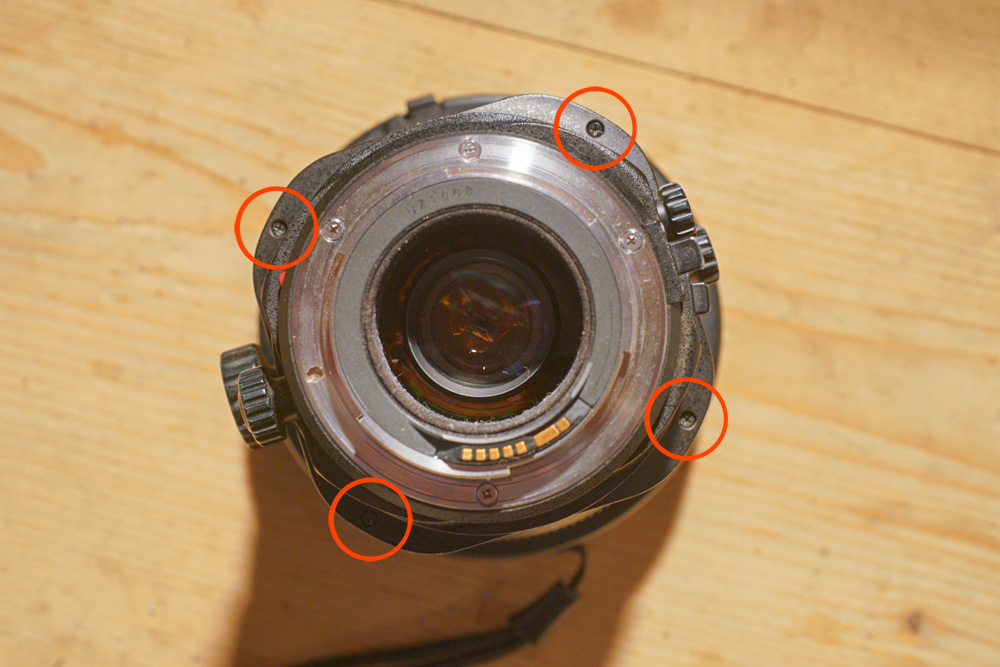
These are printed circuit connectors to be disconnected:
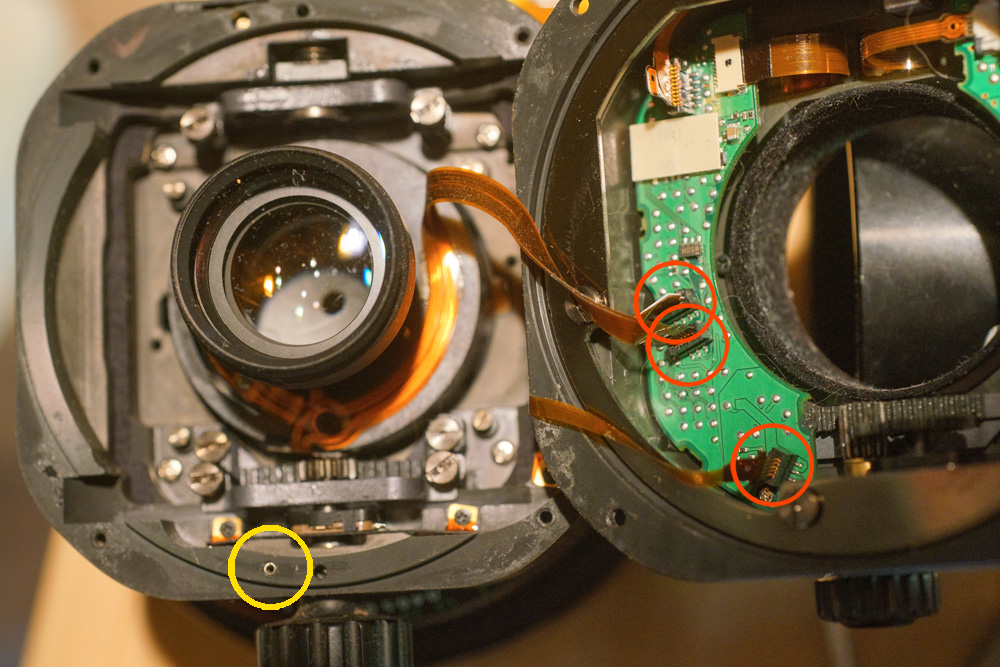
EDIT: The yellow circle in the image above shows the small spring pushing against an even smaller ball (about 1 mm). Be aware and keep that minuscule ball in a safe place (ball was removed before taking the image above).
Another view of the same connections:
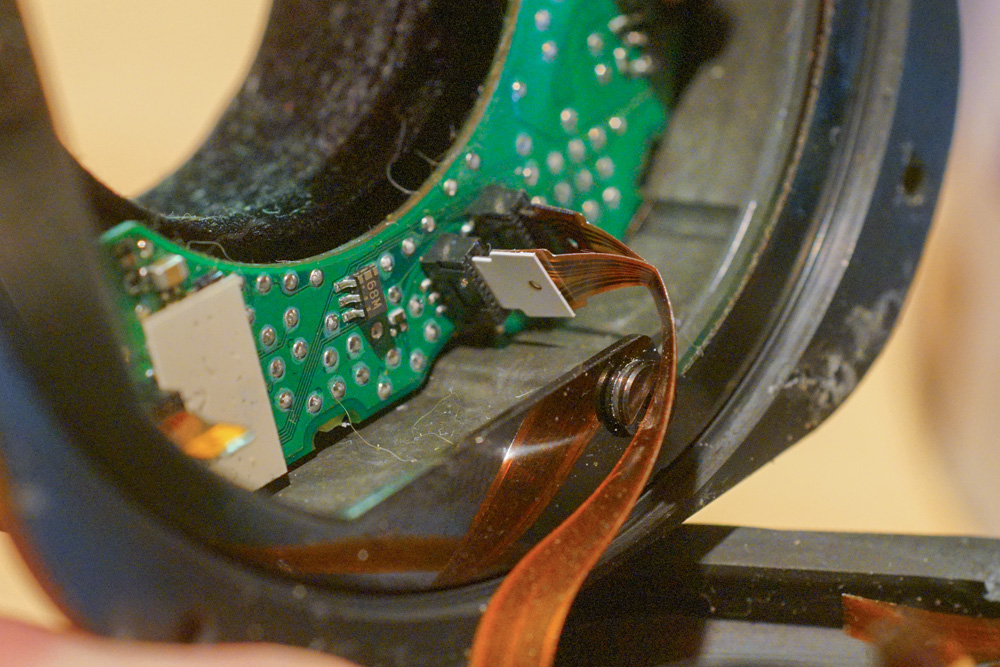
_________________
www.artaphot.ch
Last edited by stevemark on Wed Feb 22, 2023 8:18 pm; edited 2 times in total |
|
| Back to top |
|
 |
Doc Sharptail


Joined: 23 Nov 2020
Posts: 987
Location: Winnipeg Canada
|
 Posted: Wed Feb 22, 2023 7:23 pm Post subject: Posted: Wed Feb 22, 2023 7:23 pm Post subject: |
 |
|
Doc Sharptail wrote:
Cat/dog/pet hair 
Good luck with it!
-D.S.
_________________
D-810, F2, FTN.
35mm f2 O.C. nikkor
50 f2 H nikkor, 50 f 1.4 AI-s, 135 f3.5 Q,
50 f2 K nikkor 2x, 28-85mm f3.5-4.5 A/I-s, 35-105 3.5-4.5 A/I-s, 200mm f4 Micro A/I, partial list.
"Ain't no half-way" -S.R.V.
"Oh Yeah... Alright" -Paul Simon |
|
| Back to top |
|
 |
stevemark

Joined: 29 Apr 2011
Posts: 3754
Location: Switzerland
|
 Posted: Wed Feb 22, 2023 7:47 pm Post subject: Posted: Wed Feb 22, 2023 7:47 pm Post subject: |
 |
|
stevemark wrote:
Now we have the shift mechanism separated from the rest of the lens. Removing the bayonet is next. You need to unscew just the three red screws. The yellow on can remain.

Once the bayonet is removed, we can unscrew the large black baffle in the center:
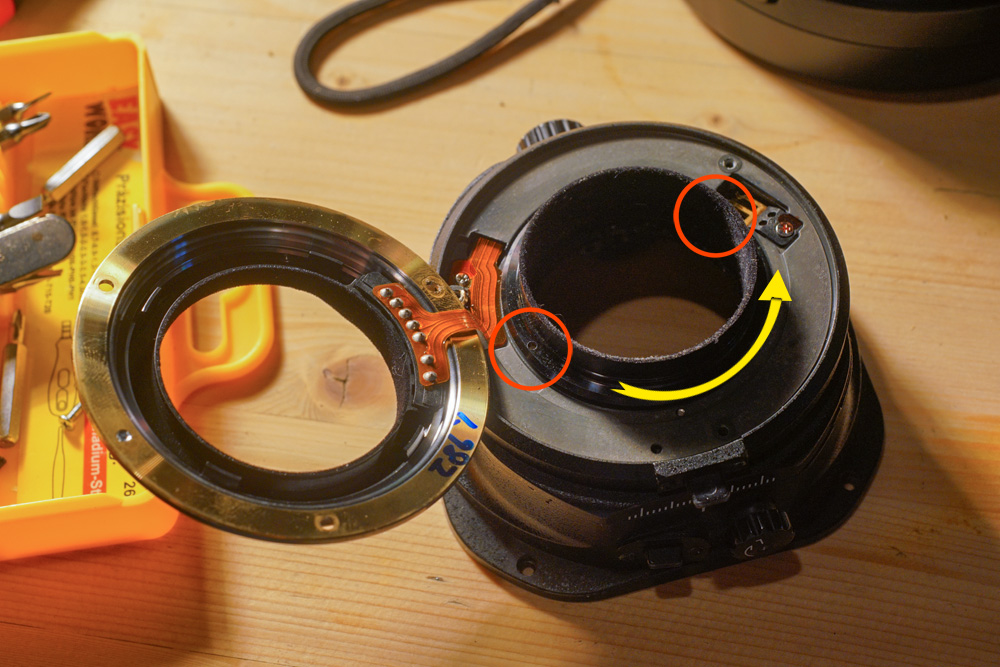
As soon as it is unscrewed, the turning part of the shifting mechanism becomes loose:
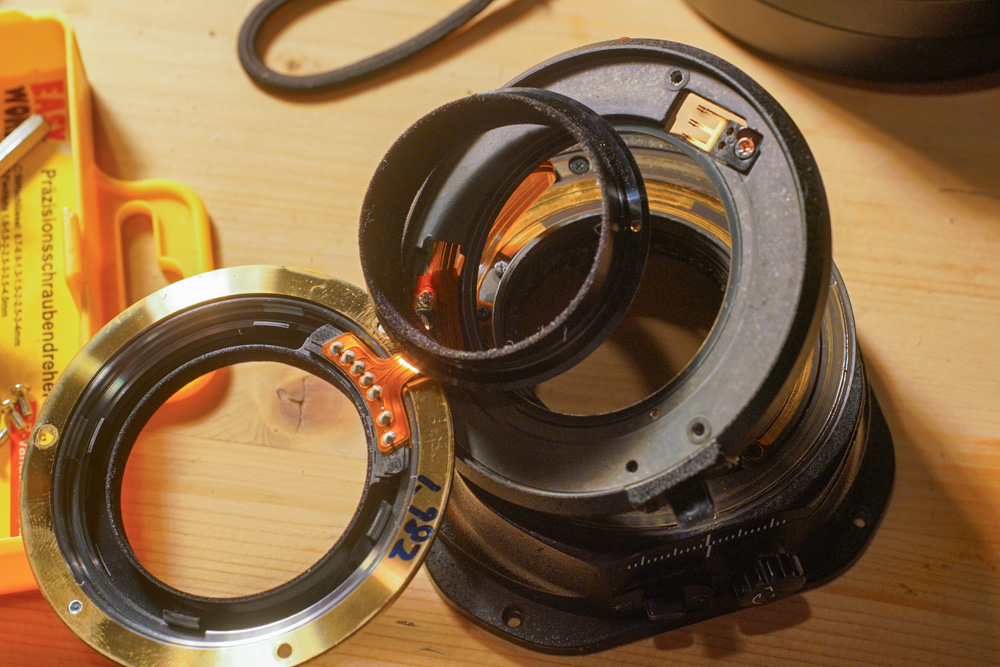
Another view of bayonet (left, below), turning mechanism (left, above) and shifting mechanism (right):

Be aware that there's a pin which can be lost (it is not attached to the rest of the shifting mechanism). It's best to take it out and put it in safe place:
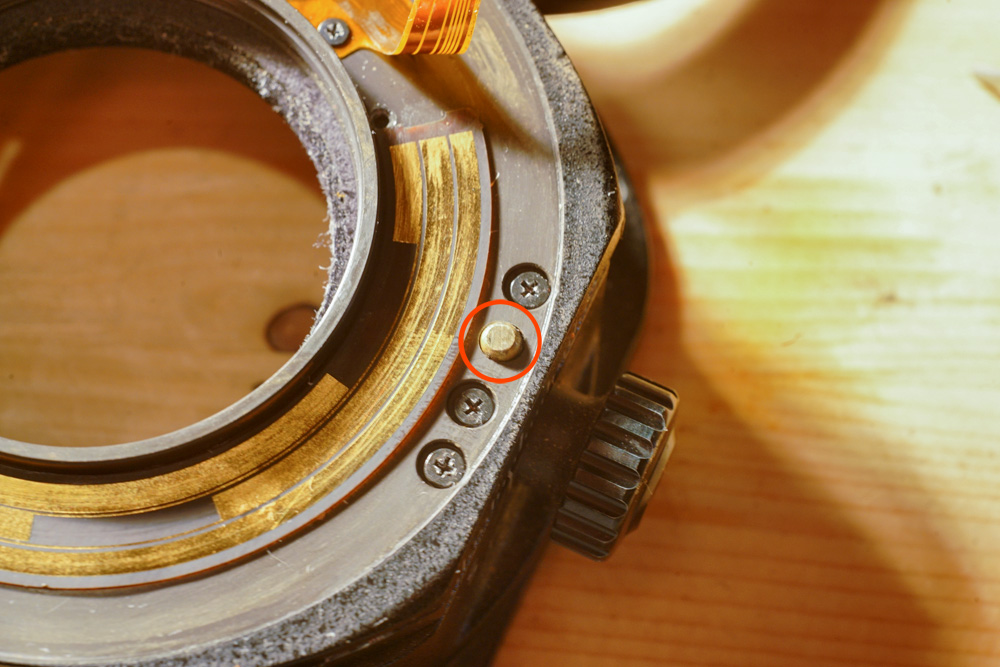
_________________
www.artaphot.ch
Last edited by stevemark on Wed Feb 22, 2023 8:11 pm; edited 1 time in total |
|
| Back to top |
|
 |
RokkorDoctor


Joined: 27 Nov 2021
Posts: 1267
Location: Kent, UK
|
 Posted: Wed Feb 22, 2023 7:51 pm Post subject: Posted: Wed Feb 22, 2023 7:51 pm Post subject: |
 |
|
RokkorDoctor wrote:
Does that yellow circle in the second image in this thread indicate one of those pesky spring-loaded click-stop balls that go fly across the room never to be found again?
Good luck with the cleaning; sounds like maybe some hard grit got caught in the shifting dovetail.
EDIT: something funny going on; I tried to delete this post to keep Stephan's posts flowing uninterrupted, but the delete option from the Edit/Delete has disappeared...?
_________________
Mark
SONY A7S, A7RII + dust-sealed modded Novoflex/Fotodiox/Rayqual MD-NEX adapters
Minolta SR-1, SRT-101/303, XD7/XD11, XGM, X700
Bronica SQAi
Ricoh GX100
Minolta majority of all Rokkor SR/AR/MC/MD models made
Sigma 14mm/3.5 for SR mount
Tamron SP 60B 300mm/2.8 (Adaptall)
Samyang T-S 24mm/3.5 (Nikon mount, DIY converted to SR mount)
Schneider-Kreuznach PC-Super-Angulon 28mm/2.8 (SR mount)
Bronica PS 35/40/50/65/80/110/135/150/180/200/250mm
Last edited by RokkorDoctor on Wed Feb 22, 2023 9:52 pm; edited 1 time in total |
|
| Back to top |
|
 |
stevemark

Joined: 29 Apr 2011
Posts: 3754
Location: Switzerland
|
 Posted: Wed Feb 22, 2023 9:15 pm Post subject: Posted: Wed Feb 22, 2023 9:15 pm Post subject: |
 |
|
stevemark wrote:
Now we finally can dismantle the shift mechanism itself. First we can remove the three rather large screws above the turning knob of the shift mechanism:
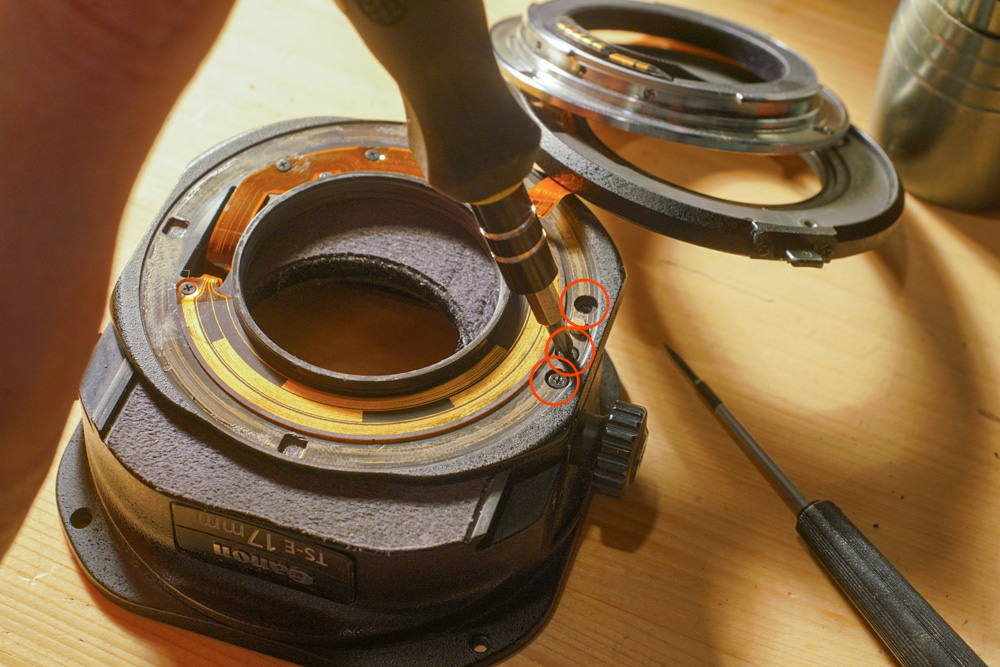
The shift mechanism remains unaccessible. I am looking for further screws to open the top of the remaining body. Since I can't find other screws, I try those - but they just fix the printed circuits. NO NEED TO REMOVE THEM!!
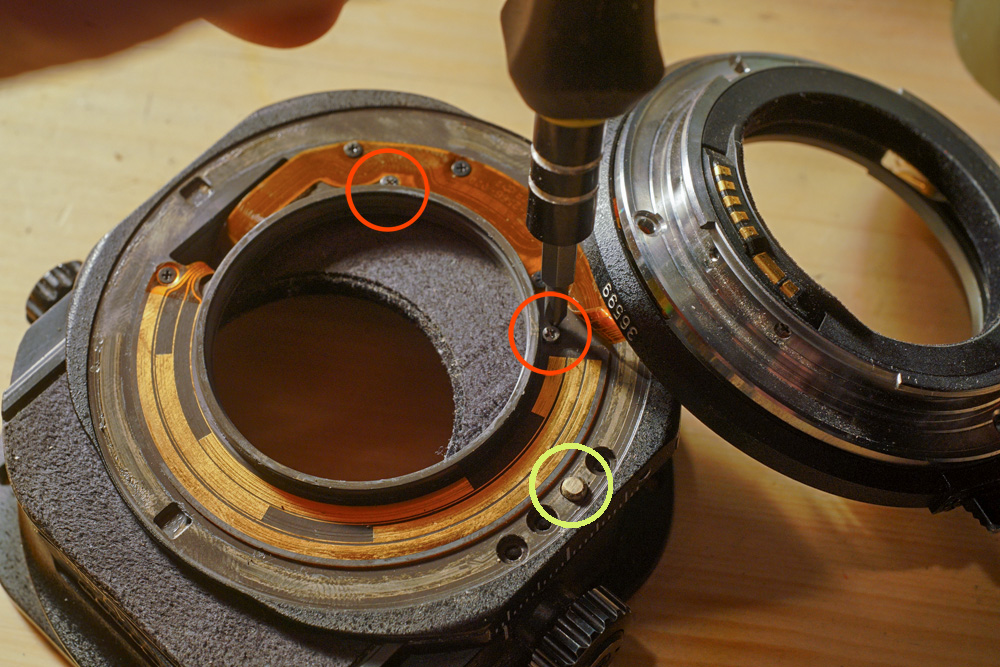
Looking carefully at the mechanism, I can't find the solution. Maybe those scews close to the knob? NO! Again: DON'T REMOVE THEM!
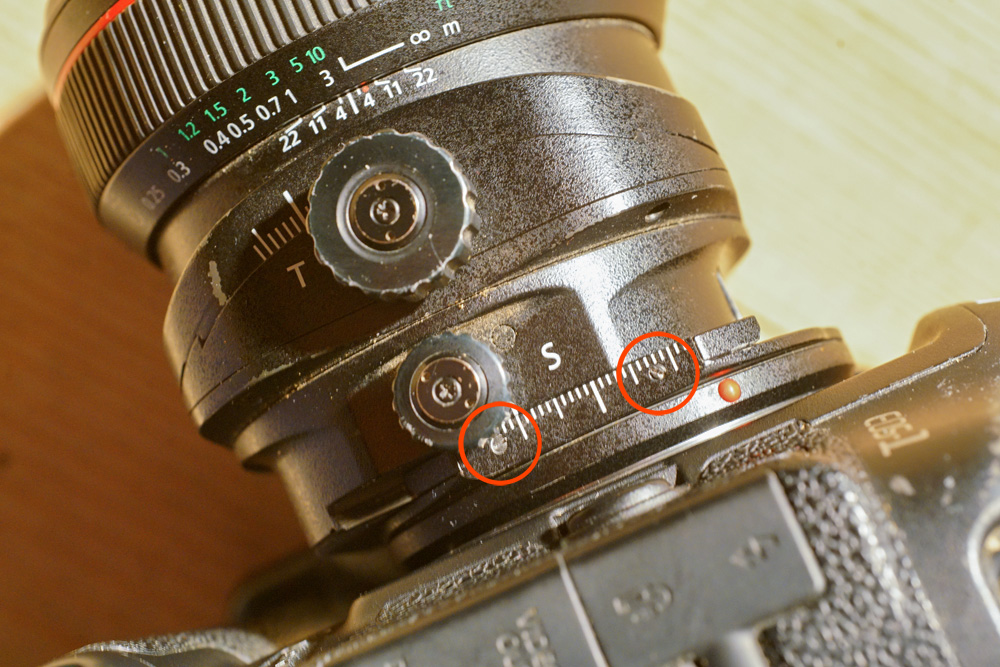
Finally I start removing the printed circuit board, and here we have the solution! Just remove that strangely slotted screw (I have no idea why it doesn't have a "normal" screw):
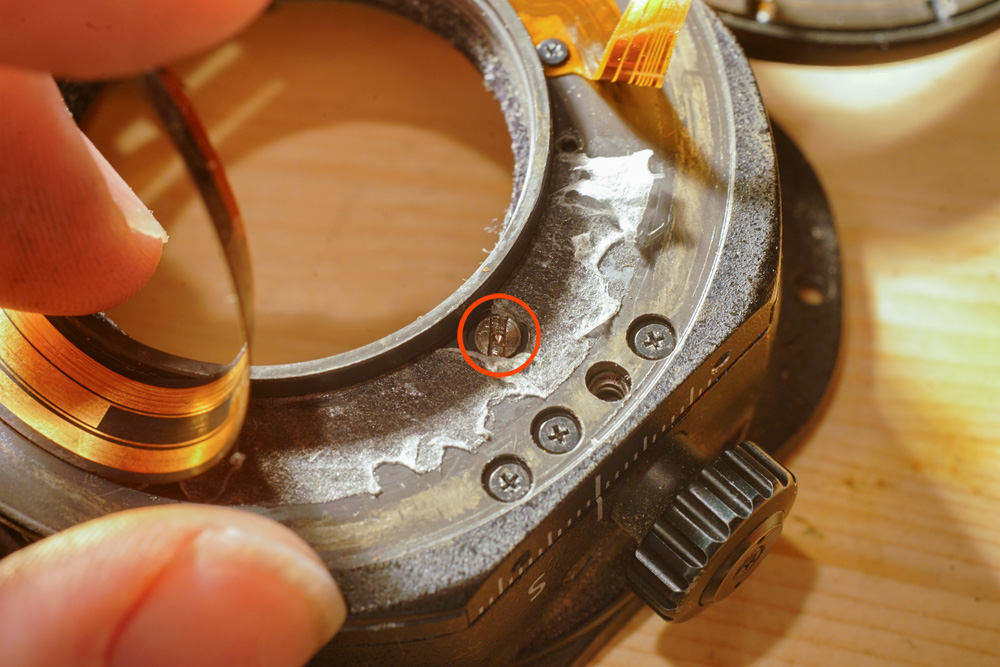
Removing the cover gives us access to the actual shifting mechanism:

Before dismantling it we should disconnect these connectors:
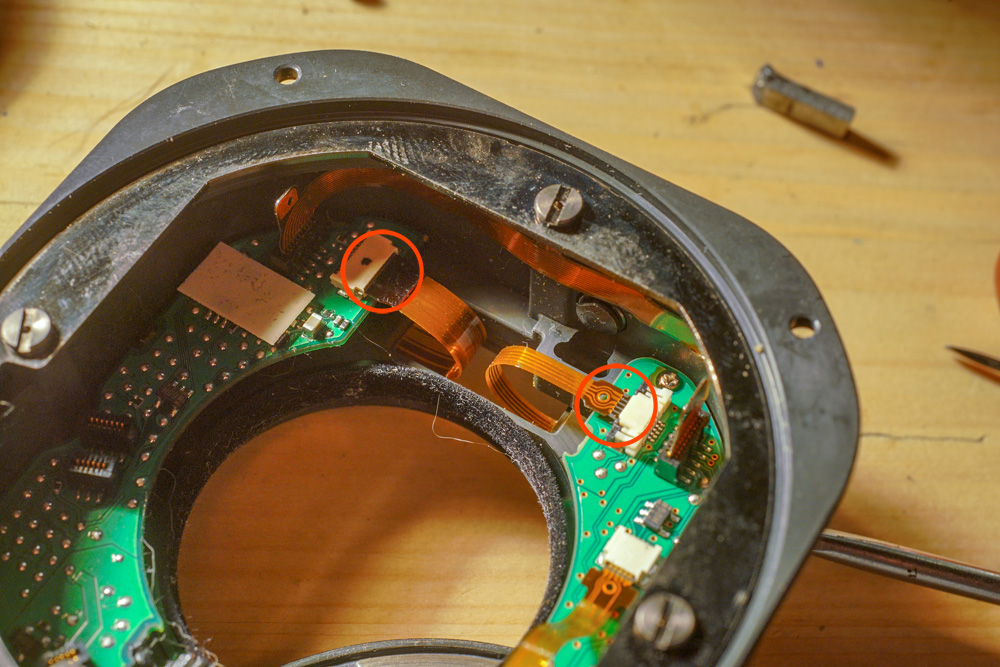
Now "everything" falls apart! Be aware of yet another spring / ball !!
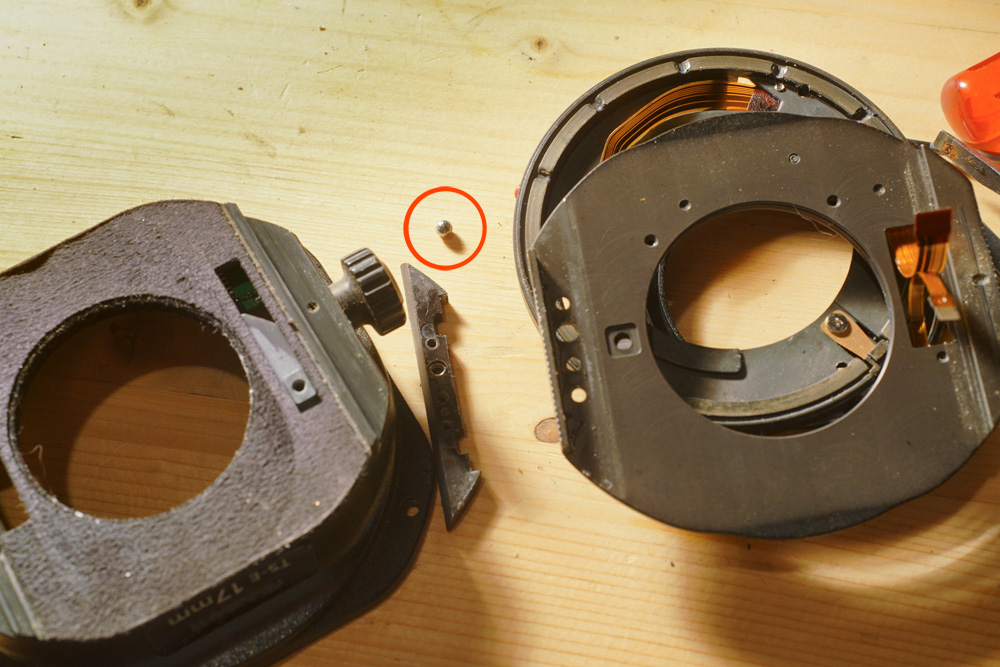
There's also a small bolt (about 1 cm long) falling out - more on that one later:

_________________
www.artaphot.ch |
|
| Back to top |
|
 |
stevemark

Joined: 29 Apr 2011
Posts: 3754
Location: Switzerland
|
 Posted: Wed Feb 22, 2023 9:48 pm Post subject: Posted: Wed Feb 22, 2023 9:48 pm Post subject: |
 |
|
stevemark wrote:
Now it's pretty easy to clean the entire shifting mechanism. I suspect a simple, small grain of sand (or something similar) to have cause the blockage. There are signs of such a problem on one of the guide rails (red circle; the yellow circle shows again the third spring / ball one should be aware of):

In addition to cleaning I have been grinding/polishing the slightly damaged area above, using a very fine abrasive paper (grain size about 10 micrometer).
Here are some more details of the shifting mechanism:
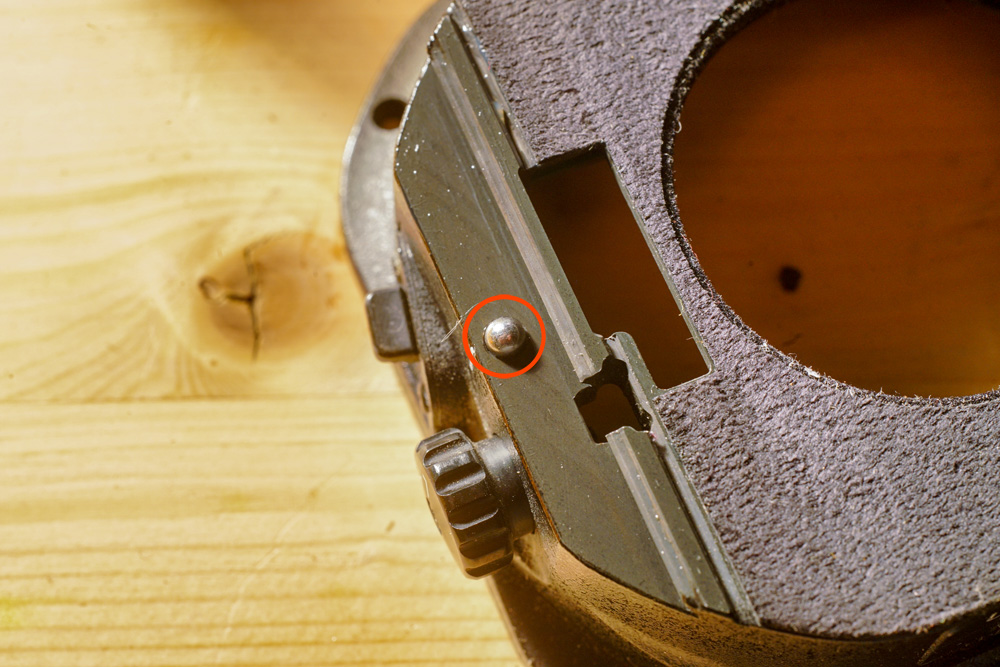
Now we ca re-assemble the entire mechanism. It's pretty straight-forward - with one exception: Remember that 1 cm bolt? It's used to block the shifting mechanism if necessary, using one of the turning knobs on the TS-E 4/17mm L. It has to in the right position before re-assembling the shifting mechanism. The first shiws the correct orientation of the bolt:
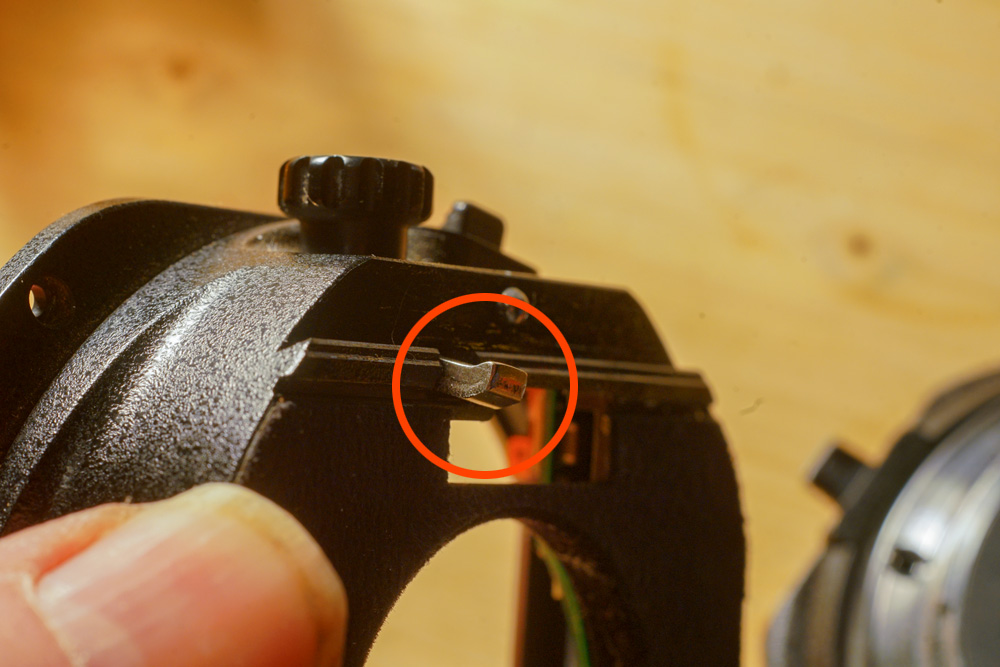
The second image shows the correct position (ready to mount the shifting mechanism):

Everything else should be pretty easy - just going backwards 
I have used a little bit of grease on the shifting rails; now shifting feels super smooth again, and I hope I can use the lens for another ten or fifteen years 
S
_________________
www.artaphot.ch |
|
| Back to top |
|
 |
stevemark

Joined: 29 Apr 2011
Posts: 3754
Location: Switzerland
|
 Posted: Wed Feb 22, 2023 11:19 pm Post subject: Posted: Wed Feb 22, 2023 11:19 pm Post subject: |
 |
|
stevemark wrote:
Finally an image of the lens block (center), the shifting mechanism (left) and the tilting mechanism (right). Very clean modular construction indeed.
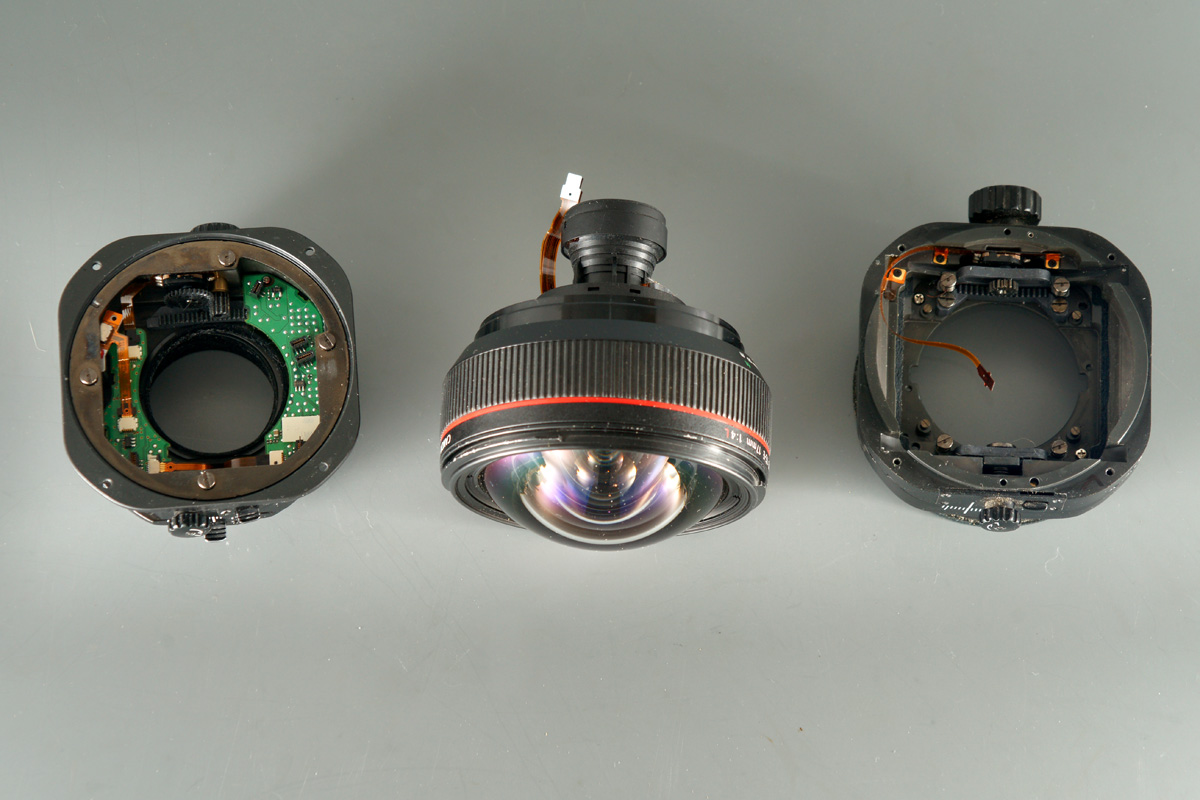
S
_________________
www.artaphot.ch |
|
| Back to top |
|
 |
RokkorDoctor


Joined: 27 Nov 2021
Posts: 1267
Location: Kent, UK
|
 Posted: Thu Feb 23, 2023 11:57 am Post subject: Posted: Thu Feb 23, 2023 11:57 am Post subject: |
 |
|
RokkorDoctor wrote:

Another lens saved!
This is why it is always a good idea to reset the shift & tilt back to zero when storing such lenses; it prevents dust & grit from settling on the exposed greased dovetail slide surfaces during storage.
Interesting to see that the tilt, shift & rotation movements all seem to have digital (and/or analogue) encoders. Are the T/S movements of this lens communicated to the camera?
_________________
Mark
SONY A7S, A7RII + dust-sealed modded Novoflex/Fotodiox/Rayqual MD-NEX adapters
Minolta SR-1, SRT-101/303, XD7/XD11, XGM, X700
Bronica SQAi
Ricoh GX100
Minolta majority of all Rokkor SR/AR/MC/MD models made
Sigma 14mm/3.5 for SR mount
Tamron SP 60B 300mm/2.8 (Adaptall)
Samyang T-S 24mm/3.5 (Nikon mount, DIY converted to SR mount)
Schneider-Kreuznach PC-Super-Angulon 28mm/2.8 (SR mount)
Bronica PS 35/40/50/65/80/110/135/150/180/200/250mm |
|
| Back to top |
|
 |
stevemark

Joined: 29 Apr 2011
Posts: 3754
Location: Switzerland
|
 Posted: Thu Feb 23, 2023 4:43 pm Post subject: Posted: Thu Feb 23, 2023 4:43 pm Post subject: |
 |
|
stevemark wrote:
| RokkorDoctor wrote: |

Another lens saved!
This is why it is always a good idea to reset the shift & tilt back to zero when storing such lenses; it prevents dust & grit from settling on the exposed greased dovetail slide surfaces during storage. |
I never use the tilting mechanism on the TS-E 4/17mm (and the Zeiss PC-Distagon 2.8/35mm doesn't have one). The gear mechanism (gear rack / gear wheel) of the TS-E 4/17 is exposed anyway - whether shifted or not. Of course the sliding racks are protected in "zero" position, but in my case the problem arose rather suddenly while I was working. Something, somehow had entered the system ...
We know now that cleaning of the 17mm (and probably of the other TS-E lenses as well) is rather easy. And I tend to replace my professional gear rather regularly. I had three Minolta / Sony 2.8/70-200G, three Zeiss 2.8/16-35, and two Zeiss 2.8/24-70 during the past years - along with about six or seven A900 cameras (not talking about the A7 series since I use them mainly for vintage stuff). And a couple of MinAF 2.8/200 APO (four), 1.4/85 (two) and 2/100 (three) lenses.
Most photographers here exchange their stuff after three years, either for improved gear or for a new sample of a proven item. So my TS-E 17mm - now seven years old - is a bit of an exception (just like other lenses I rarely use, e. g. the 2.8/400 L)
| RokkorDoctor wrote: |
| Interesting to see that the tilt, shift & rotation movements all seem to have digital (and/or analogue) encoders. Are the T/S movements of this lens communicated to the camera? |
Yep, I was astonished as well. As you know there are four separate mechanisms
1) Rotation entire lens 180° (=shifting & tilting mechanism)
2) Shifting +/- 12mm
3) Rotation front part 90° (= only tilting mechanism)
4) Tilting
I have dismantled only the shifting mechanism, and bot Rotation (1) as well as Shifting (2) are encoded. I strongly suspect that Tilting (3) and the Rotation of the front part (4) are encoded as well.
You get a lot of bang for buck with those Canon shift lenses. The corresponding Nikkor 19mm shift, BTW, has much more distortion than the 17mm Canon. Even on critical shots I really have to look for some remaining distortion when using the Canon. On the Nikkor 19mm shift distortion is pretty easily visible (I cheked when it came on the market).
S
_________________
www.artaphot.ch |
|
| Back to top |
|
 |
Himself

Joined: 01 Mar 2007
Posts: 3214
Location: Montreal
Expire: 2013-05-30
|
 Posted: Sun Feb 26, 2023 11:44 pm Post subject: Posted: Sun Feb 26, 2023 11:44 pm Post subject: |
 |
|
Himself wrote:
It looks to have a lot of dust especially on the rear element.
Where/how do yo keep it? No rear cap - bottom up all the time?
None of my lenses have that amount of dust on rear element. They are pristine.
And what you have there it's a very expensive lens.
_________________
Moderator Himself |
|
| Back to top |
|
 |
stevemark

Joined: 29 Apr 2011
Posts: 3754
Location: Switzerland
|
 Posted: Sun Mar 12, 2023 2:45 am Post subject: Posted: Sun Mar 12, 2023 2:45 am Post subject: |
 |
|
stevemark wrote:
| Himself wrote: |
It looks to have a lot of dust especially on the rear element.
Where/how do yo keep it? No rear cap - bottom up all the time?
None of my lenses have that amount of dust on rear element. They are pristine.
And what you have there it's a very expensive lens. |
Sorry for my late answer!
My working gear is used quite "carelessly" indeed. When working, my awareness usually is focused on the subject, and not on the gear. Actually I really do not like gear that needs too much of my attention (Sony [ie Minolta] A900 is excellent, Sony A7 series is demanding). Inevitably dust is creeping into the large equipment backback; therefore after 2 years I regularly get new ones. And there's a lot of dust here, believe me ... !
I have noticed that the outer glass surfaces - especially "newer" lenses produced after 1980 - usually are pretty rugged, and quite immune against common dust. Unless you really apply pressure ("rubbing" a dusted glass surface), no damage is done. In the case of this problem with the 17mm shift mechanism probably a very small grain of quartz sand/dust hast entered the shifting mechanism, and quite suddenly is was kind of blocked (I was working outside while it happened, and had changed the lens several times during the day).
As I said earlier, most photogaphers here replace their gear pretty regularly (three years). Often, working quickly is much more important than keeping all dust off the lens surfaces!
My oldest Minolta AF lenses - including an AF 1.4/50mm and an AF 4/70-210mm from 1988 - still have no marks on the glass, even though I've cleaned them many times (carefully, though - using a drop of detergent in maybe 0.5 dl of water, and then wiping the lens with a moistened soft paper).
Actually too much heat (and sometimes cold) is much more troublesome than dust. Several of my vintage lenses were damaged due to "high" temperatures (40-45°C / 100-120F), usually causing oily aperture blades. A few were damaged due to "cold" as well (-5 to 0°C / 20-30F), especially some old Mamiya stuff (the rubber on the focusing rings) ...
S
_________________
www.artaphot.ch |
|
| Back to top |
|
 |
|
|
|
You cannot post new topics in this forum
You cannot reply to topics in this forum
You cannot edit your posts in this forum
You cannot delete your posts in this forum
You cannot vote in polls in this forum
|
